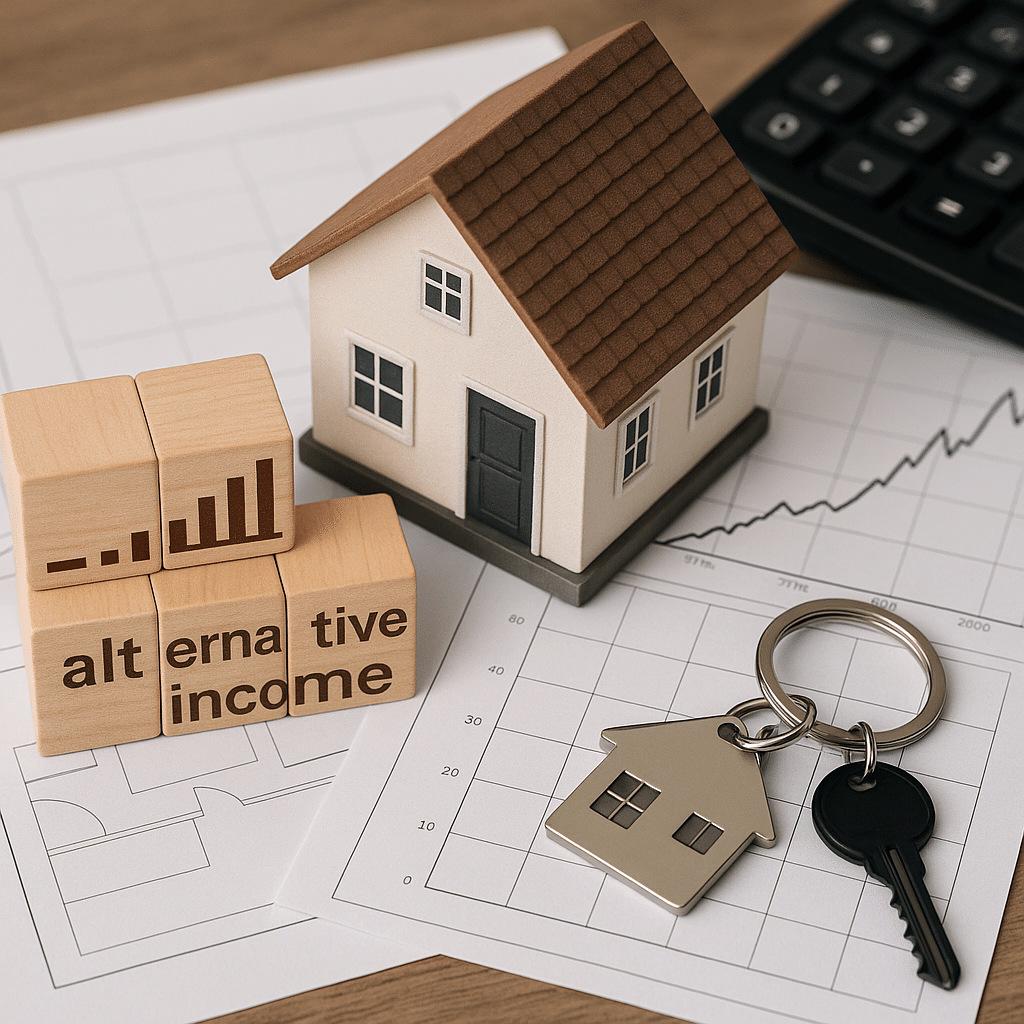Picture this: You’ve built a successful freelance business, but every time you think about applying for a mortgage, the same hurdle pops up. No W-2s. No traditional pay stubs. Just a steady stream of client payments and 1099s – enough to support a home, but not the kind of income most banks are set up to review. Sound familiar? You’re not alone. Many would-be buyers run into this wall, only to discover a different path: the alternative income mortgage.
Understanding Alternative Income Mortgages
Definition and Core Concept
An alternative income mortgage is exactly what it sounds like – a home loan designed for people who don’t fit the mold of the classic nine-to-five employee. Instead of relying solely on W-2s and tax returns, lenders look at other forms of income documentation to assess your ability to repay.
How They Differ From Traditional Mortgages
Traditional mortgages usually expect proof of regular employment and predictable paychecks. Lenders want W-2 forms, pay stubs, and sometimes multiple years of tax returns. With an alternative income mortgage, the door opens wider: bank statements, contractor 1099s, or even evidence of regular rental income can help make your case.
Why These Loans Exist: The Changing Landscape of Income Documentation
Work has changed. The gig economy is booming, more people start their own businesses, and retirees often draw from investments instead of a job. Lenders created alternative income mortgages to keep up – recognizing that steady income doesn’t always look the same on paper.
Who Might Need an Alternative Income Mortgage?

Common Borrower Profiles
– Self-employed professionals: Think small business owners, consultants, or solo entrepreneurs.
– Freelancers and gig workers: Graphic designers, rideshare drivers, writers – anyone with multiple clients or contracts.
– Retirees: Those living off Social Security, pensions, or investment portfolios.
– Commission-based workers: Real estate agents, salespeople, or anyone whose pay fluctuates month to month.
Typical Life and Work Scenarios
Maybe you’ve been freelancing for years but never drawn a salary. Or perhaps you own several rental properties and rely on that income to pay your bills. Even retirees who no longer get a paycheck but have substantial assets may consider this route. If your income is real but not regular in the eyes of a traditional lender, alternative income mortgages can bridge the gap.
How Alternative Income Mortgages Work
Qualifying Income Types
Lenders have broadened their horizons. Instead of just scanning for W-2s, they may accept:
– Bank statements: Usually covering 12 – 24 months, showing consistent deposits.
– 1099 forms: For those paid as independent contractors.
– Asset depletion: Using retirement accounts or investments as proof you can cover payments.
– Rental income: Documented through leases or bank deposits from tenants.
Documentation Lenders May Request
Expect a deeper dive into your financial life. Be ready to provide:
– Several months (often 12 – 24) of bank statements.
– Tax returns (sometimes optional, depending on the program).
– Proof of business ownership or professional licensing.
– Documentation for any significant deposits – lenders want to know where the money comes from.
– Asset statements if you’re using savings or investments as qualifying income.
How Lenders Assess Risk Without W-2s
Without standard paychecks, lenders take extra steps. They’ll look for consistency – predictable deposits over time matter more than one big windfall. Large unexplained deposits can raise red flags (see field note below). They’ll also weigh your credit score, debt-to-income ratio, and available assets more heavily than in a traditional process.
Benefits and Drawbacks to Consider

Flexibility for Non-Traditional Earners
The biggest advantage? Flexibility. These loans open homeownership to people whose income is steady but unconventional. You don’t need a boss or a clock-in sheet – just proof that you can handle the payments.
Potential for Higher Rates or Down Payments
There’s a trade-off. Since lenders are taking on more risk without standard documentation, you might see:
– Slightly higher interest rates.
– Larger required down payments (sometimes 10 – 20%).
– Additional fees or stricter underwriting conditions.
Impact on Loan Limits and Approval Timelines
Alternative income loans sometimes cap how much you can borrow, especially if your documented income varies month-to-month. And don’t be surprised if the process takes longer – underwriting these loans means more paperwork and closer scrutiny.
Practical Steps: Applying for an Alternative Income Mortgage
How to Prepare Your Documentation
Start early. Gather at least two years’ worth of bank statements. Highlight regular client payments or other recurring deposits. If you have 1099s, organize them by year and client. For asset-based loans, pull recent investment account statements.
Questions to Ask Your Lender
– Which forms of alternative income do you accept?
– How many months of documentation do I need?
– What’s the timeline from application to closing?
– Will my rate or down payment be higher than average?
Tips for Improving Your Application’s Strength
– Keep personal and business finances separate.
– Avoid large unexplained deposits – document every source.
– Pay down existing debts where possible.
– Maintain good credit – lenders still care about your score.
Mini-Case: From Freelance to Homeowner
A freelance graphic designer with two years of steady contract work wants to buy a home but lacks W-2s. They gather 24 months of bank statements showing consistent deposits from multiple clients and work with a lender familiar with alternative income loans. The process takes a bit longer and requires extra documentation compared to a standard loan, but in the end, the designer secures a mortgage – and gets their keys.
Key decisions included choosing a lender who understood freelance income and preparing thorough documentation upfront. The biggest challenge? Explaining a few larger-than-usual client payments. The designer learned that transparency and organization made all the difference.
Field Note: What Borrowers Often Miss
Many applicants don’t realize that large, unexplained deposits in their bank statements can trigger extra questions or delays. Lenders want to see predictable, business-related income – not one-off windfalls. If you’re depositing cash gifts or selling items online, keep records that show where those funds came from – or avoid mixing them with your qualifying income altogether.
Questions to Ask Before Choosing an Alternative Income Mortgage
Consider these before making your decision:
1. Is my income history stable enough to qualify, even if it’s non-traditional?
2. Am I comfortable with potentially higher rates or stricter documentation requirements?
3. Do I have a lender experienced in alternative income mortgage programs?
FAQ: Alternative Income Mortgages
Q: Can I get an alternative income mortgage if I have inconsistent income?
A: Yes, many alternative income mortgages are designed for borrowers with fluctuating or seasonal income, as long as you can show a reliable pattern over time.
Q: What documents do I need for an alternative income mortgage?
A: You may need 12 – 24 months of bank statements, 1099 forms, proof of assets, or evidence of rental income, depending on the lender’s requirements.
Q: Are rates higher for alternative income mortgages?
A: Rates can be higher than traditional mortgages, since lenders take on more risk without standard income proof. It’s wise to compare offers and ask about all fees.
Alternative income mortgages aren’t just for the self-employed – they’re built for anyone whose earnings don’t fit into tidy boxes. With preparation and the right lender, that unconventional path can still lead straight home.
